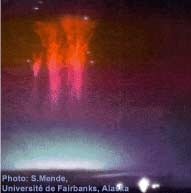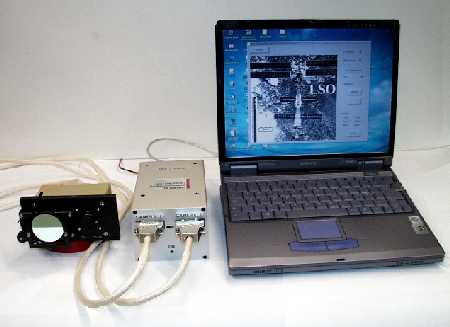 |
 |
 |
 |
 |
 |
 |
 |
 |
 |
Scientific files |
 |
 |
| |

 |
A CEA experiment aboard the International Space Station |

 Contents Contents
 Schedule Schedule
The aim of the LSO (Lightning and Sprite Observations) experiment is to observe certain light emissions generated by lightning from the International Space Station (ISS).
The CEA designed and developed the experimental device required for this experiment and delivered it to the CNES (French National Space Studies Center) on June 22, 2001. This device will be aboard the Progress rocket due to launch on September 15, 2001. Observations will be made aboard the ISS from September 21 to 28.
 Experiment Experiment
Red sprites, elves and blue jets are the main emissions being studied. Red sprites are luminous flashes produced in the middle atmosphere above thunderstorms and that extend up to altitudes of some 100 kilometers. They often appear in groups and other types of emissions, such as elves and blue jets, can also occur at the same time. Elves appear as disks at the base of the ionosphere at altitudes of approximately a hundred kilometers. Other types of X and gamma radiation can occur at the same time as these luminous emissions.

 |
Experiment device |
The long-term aim is to identify the mechanisms that underlie atmosphere-ionosphere-magnetosphere coupling interactions above atmospheric thunderstorms. These areas are very important given their role in solar radiation (ozone layer) filtering and radiocommunications (ionosphere).
The experiment, designed by the DASE and developed with the DCRE (another division of the CEA specialized in experiment design and performance), uses two micro-cameras (110g, approx. 8x5cm) controlled by an electronic interface and a computer. One of the micro-cameras is equipped with a filter specially designed for sprite observation. The other micro-camera takes pictures of lightning in the visible spectrum. These cameras will be fixed to a porthole and used at night above continents as thunderstorms are scarcer above oceans.
The LSO experiment will enable us to characterize elves and sprites and to assess the feasibility of a future microsatellite mission designed to improve overall knowledge of sprites and associated phenomena.
 Videos Videos
 |

 |
Thunderstorm in Argentina seen from the space shuttle during the STS-58 mission.
A mesoscale convective thunderstorm complex of approximately 930 km can be seen. The clouds are visible thanks to the moonlight. The intense, brief luminous patches are intracloud lightning.
MPEG film production courtesy of the Engineering Photo Analysis Group of the MSFC Propulsion Laboratory. |
| |
|
|
| |
 |
Sprite observation by D. Sentman from the Geophysical Institute, University of Alaska Fairbanks. |
|
|
|